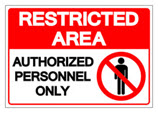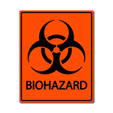Biosafety Levels and How They Affect Your Lab
June 12, 2023
Biological safety Levels
It's important to be aware of Biosafety levels and how they affect your lab. A combination of lab practices, containment equipment, and lab design make up the biosafety levels 1-4.
Door signage
BSL-1 “Admittance to Authorized Personnel Only”
BSL-2 in addition to the BSL-1 the sign must have a Biohazard Symbol and instructions on requirements for entry that may include necessary Personal Protective Equipment (PPE) or immunocompetence.
Request door signage from EHS Safety Portal (Lab Door Sign Request).
Personal Protective Equipment (PPE)
BSL-1 long pants, closed-toed shoes, long hair is tied back, lab coat or uniform is used to protect personal clothing, appropriate gloves for material being handled.
BSL-2 in addition to BSL-1 it may be necessary to wear liquid impervious gowns, longer sleeved gloves, hair bonnet, shoe covers and more depending on the materials used or how the materials are manipulated.
See the EHS Personal Protective Equipment webpage for additional information.
Facility Ventilation
BSL-1 labs need fly screens in the windows that open.
BSL-2 labs in addition need negative airflow. Air flows into the lab not out to hallways or common areas. Windows are kept closed when working with the BSL-2 materials.
Biological Waste Handling
BSL-1 and BSL-2 liquid waste is treated by either autoclaving, chemically treating, or picked-up by hazardous waste team. All contaminated solid waste is collected in a biohazard bag inside of a leak-proof, puncture resistant container with lid. The lid is on the container when not in attendance at the container. The container is labeled with a biohazard sticker on to the top and sides for hazard communication.
See the EHS Hazardous Waste Management webpage for additional information.
Pest Management
BSL-1 and BSL-2 labs are required to contact IPF at the first sign pests are a problem.
IPF contact for pest management
Plants and Animals Unrelated to Research
BSL-2 labs prohibit plants and animals that are not directly involved in the research.
Training
BSL-1 requires general laboratory knowledge, online biosafety lab track and annual site – specific training.
BSL-2 in addition to BSL-1 the personnel must be proficient in microbiological practices prior to handling the agents. The PI is responsible for ensuring that proficiency has been demonstrated. For additional information see the Laboratory Safety training webpage. Required online biosafety lab track with an additional requirement of Bloodborne Pathogens Training if using unfixed human materials, as well as annual site-specific training.
Personal Electronic Devices
In BSL-2 labs PEDs are restricted or not permitted, the PI or lab supervisor will have specific restrictions depending on lab practices.
PED Examples:
- Headphones
- Airpods/earbuds
- Cell phones
- Smart phones
- Smart watches
- MP3 players
- Personal computers/laptops
- Tablets
- Electronic book readers
- Recording and playback devices
Contamination of PEDs has led to exposure and serious illness. Any materials that are removed from the lab can be a potential point of contamination and exposure. If a device is required for the research, contact the Biosafety Officer for approval prior to work beginning.
Equipment
Biosafety Cabinets are required for handling BSL-2 agents. Anytime the surface tension of a liquid is disturbed like during pipetting this creates an aerosol, requiring containment as a biosafety cabinet can provide.
Centrifuges with safety lids that seal either the entire rotor or each bucket are also required when using BSL-2 agents.
Spill kits for biological spills with appropriate disinfection are required in a BSL-2 lab. Spill procedures are to be posted within the laboratory in BSL-1.
Vacuum line filters are required between the flask and the source of the vacuum to reduce the risk of contamination to the vacuum system.

